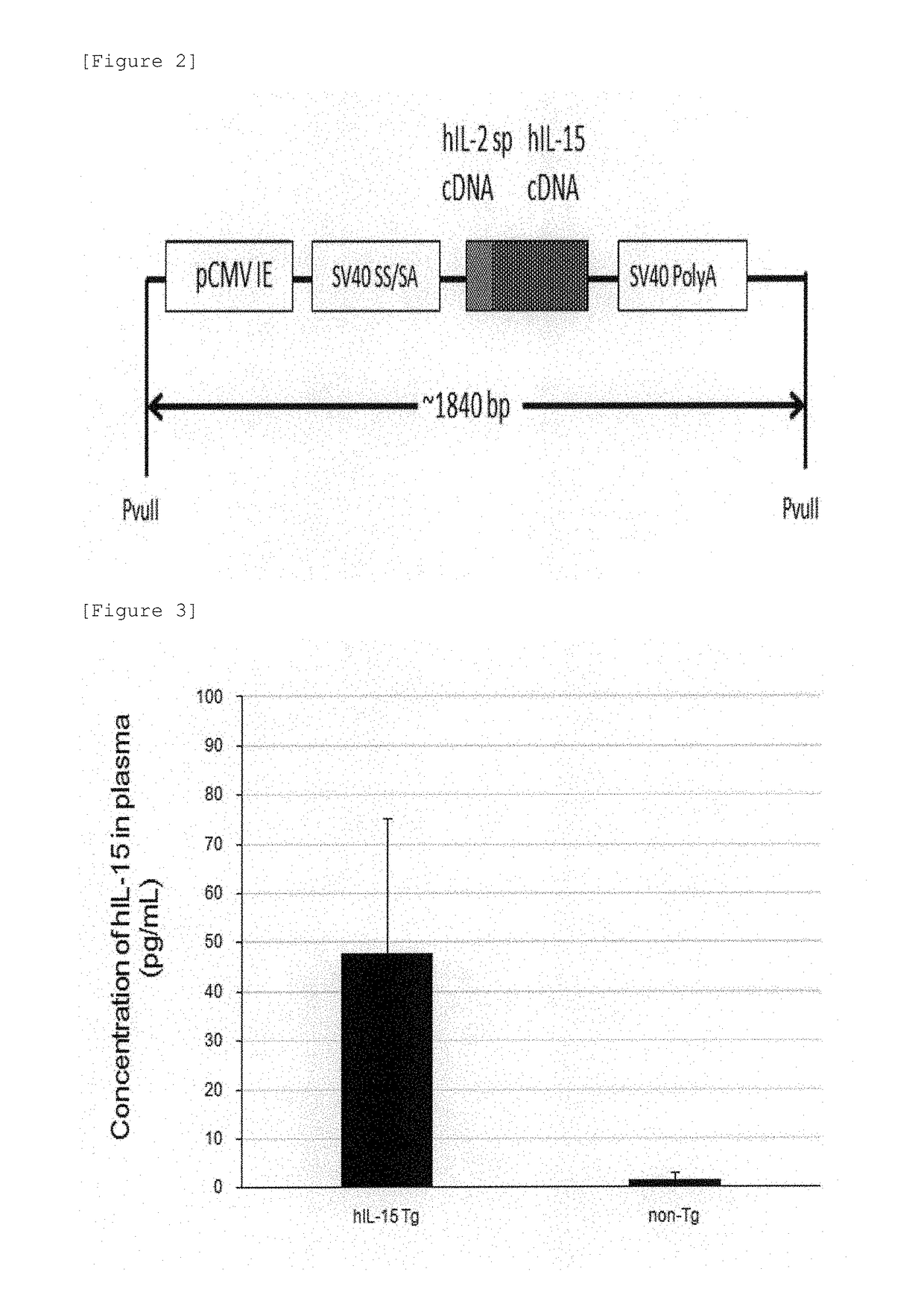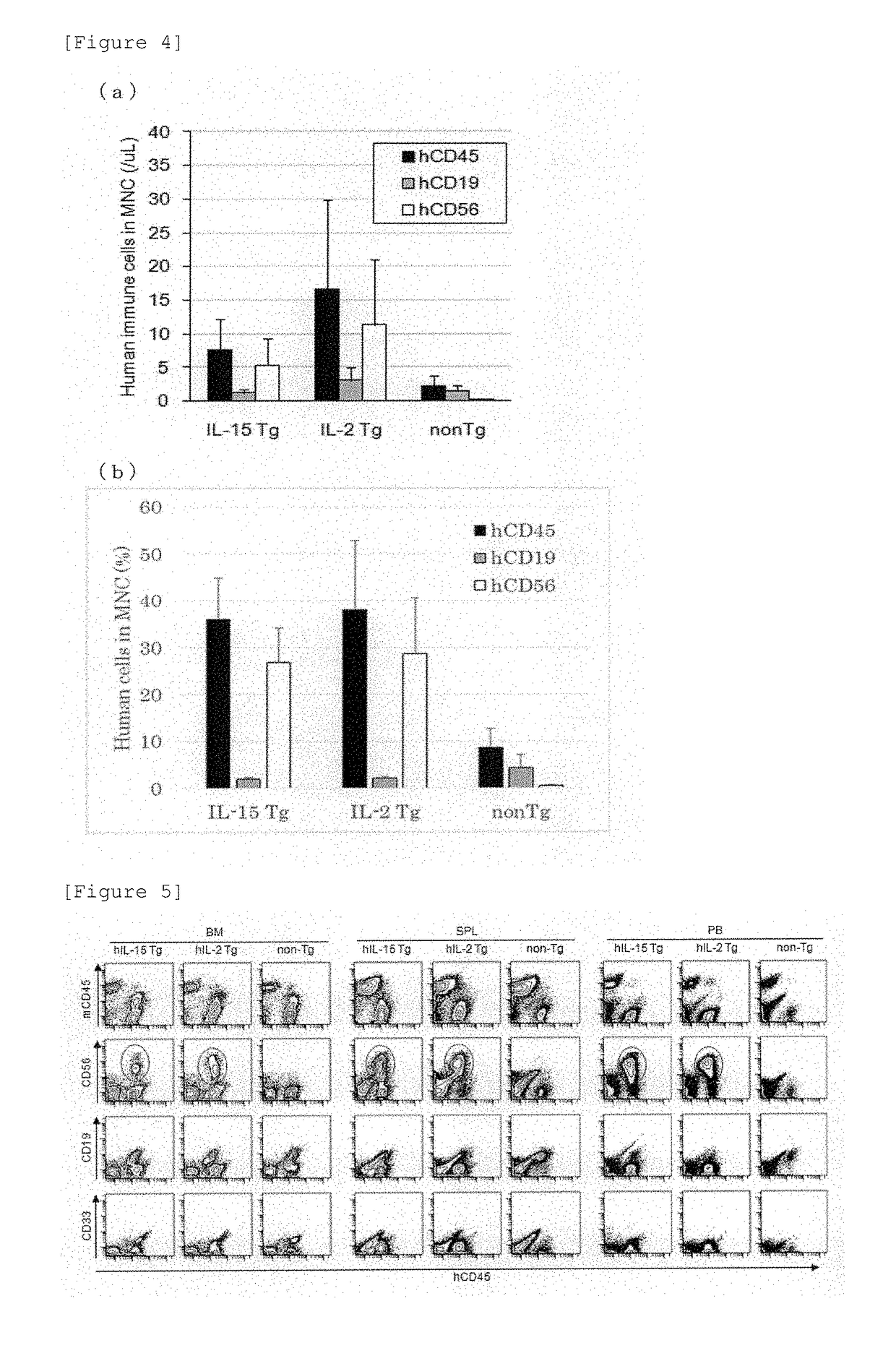Human il-15-secreting immunodeficient mouse
a human il-15 and immunodeficiency technology, applied in the field of immunodeficiency mouse, can solve the problems of short lifespan of mice, low engraftment efficiency, and inability to improve the rate of human cell engraftment to an expected level
- Summary
- Abstract
- Description
- Claims
- Application Information
AI Technical Summary
Benefits of technology
Problems solved by technology
Method used
Image
Examples
example 1
[Generation of NOD-Scid, IL-2rγnull-hIL-15 Tg Mouse Producing IL-15]
(Outline)
[0059]According to the guidance approved by the animal experiment committee of Central Institute for Experimental Animals (hereinafter, also referred to as “CIEA”), NOD-scid, IL-2rγnull-hIL-15 Tg mice were generated as transgenic mice secreting human IL-15 by using NOD-IL-2rγnull mice and NOD-scid, IL-2rγnull mice (hereinafter, also referred to as “NOG mice”). These mice are specially controlled in the SPF animal facilities of CIEA and can be distributed under predetermined conditions.
(Preparation of DNA for Injection into Fertilized Egg)
[0060]A reporter vector pCMVβ for mammals (manufactured by Invitrogen Corp.) (see FIG. 1(a)) was used to construct a vector for DNA preparation for injection into fertilized eggs in which SV40 SD / SV DNA, DNA consisting of the nucleotide sequence represented by SEQ ID NO: 1 (hIL-2SP cDNA / hIL-15 cDNA ligation product), and polyA sequence DNA were integrated in order downstrea...
example 2
[Study on NOG-hIL-15 Tg Mouse]
[0079](hIL-15 Concentration in Plasma)
[0080]The hIL-15 concentration in the plasma of the NOG-hIL-15 Tg mice was measured. Peripheral blood was collected from 4 to 6 weeks old mouse individuals under anesthesia using heparin (Novo-heparin, manufactured by Mochida Pharmaceutical Co., Ltd.). The hIL-15 concentration in the plasma was measured using the ELISA kit described above. The results are shown in FIG. 3.
(Results)
[0081]As is evident from FIG. 3, the hIL-15 concentration in the plasma of the NOG-hIL-15 Tg mice (“hIL-15 Tg” in the figure) (N=126) was 47.7±27.5 pg / mL, whereas the hIL-15 concentration in the plasma of the non-Tg mice was 1.3±1.5 pg / mL. Thus, the NOG-hIL-15 Tg mice having the insert in the genomic DNA had a remarkably higher hIL-15 concentration than that of the NOG mice, demonstrating that hIL-15 systemically produced by the gene having the nucleotide sequence represented by SEQ ID NO: 1 inserted in the genomic DNA was secreted into blo...
example 3
[Study on Ability of Human Cell to Differentiate in Human Cord Blood-Derived CD34+ Hematopoietic Stem Cell-Transplanted NOG-hIL-15 Tg Mouse]
(Flow Cytometry Measurement Procedure)
[0082]The study using flow cytometry in Example 3 or later was conducted by the following procedures: assuming that the hCD56+ cells were human NK cells, analysis was conducted using antibodies suitable for each study item. Specifically, the cells were stained at 4° C. for 30 minutes in the dark, then washed with a FACS buffer solution (PBS containing 1% FBS and 0.1% NaN3), and resuspended in a FACS buffer solution containing propidium iodide, followed by flow cytometry measurement. The flow cytometry measurement was performed using a BD FACSCanto™ flow cytometer (manufactured by Becton, Dickinson and Company). The data was analyzed using FACSDiva software (ver. 6.1.3) (manufactured by Becton, Dickinson and Company). The absolute value of the number of cells was calculated using Flow-Count (manufactured by B...
PUM
 Login to View More
Login to View More Abstract
Description
Claims
Application Information
 Login to View More
Login to View More - R&D
- Intellectual Property
- Life Sciences
- Materials
- Tech Scout
- Unparalleled Data Quality
- Higher Quality Content
- 60% Fewer Hallucinations
Browse by: Latest US Patents, China's latest patents, Technical Efficacy Thesaurus, Application Domain, Technology Topic, Popular Technical Reports.
© 2025 PatSnap. All rights reserved.Legal|Privacy policy|Modern Slavery Act Transparency Statement|Sitemap|About US| Contact US: help@patsnap.com



